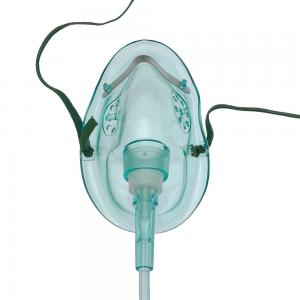

Add to Cart
High Quality Disposable Medical Oxygen Face Mask PVC Oxygen Mask
A disposable medical oxygen face mask is a device used in medical settings to deliver oxygen to a patient who requires supplemental oxygen therapy. These masks are an integral part of respiratory care, especially for patients with respiratory conditions or those in need of increased oxygen levels.
Product Description
The prosable oxygen mask is constructed to supply oxygen or other
gases to a patient, and it should be used
together with oxygen supplying tube usually. The oxygen mask is
made from PVC of medical grade, consists of face mask only.
1. Material:
- Oxygen face masks are typically made from medical-grade materials
such as PVC (polyvinyl chloride) or other soft, latex-free
materials to ensure patient comfort and safety.
2. Design:
- The face mask is designed to cover the nose and mouth of the
patient to facilitate the delivery of oxygen. It is secured to the
patient's face with an elastic strap that goes around the head.
3. Nasal Prongs or Reservoir Bag:
- Some oxygen masks come with nasal prongs that deliver oxygen
directly into the nostrils. Others may have a reservoir bag that
allows the patient to inhale a higher concentration of oxygen
during inhalation.
4. Adjustable Nose Clip:
- Many oxygen masks feature an adjustable nose clip to ensure a
secure and comfortable fit on the patient's face.
5. Different Types and Sizes:
- There are various types and sizes of disposable oxygen masks to
accommodate different patient needs, including adult masks and
pediatric masks. The choice depends on factors such as age, size,
and the patient's respiratory condition.
6. Flow Rate Compatibility:
- Oxygen masks are designed to work with specific flow rates of
oxygen. The healthcare provider prescribes the appropriate flow
rate based on the patient's needs.
7. Single-Use:
- Disposable oxygen masks are intended for single-use only. After
use, they are discarded to prevent the risk of cross-contamination.
8. Transparent Design:
- Some oxygen masks are transparent, allowing healthcare providers
to visually assess the patient's condition and monitor for any
signs of respiratory distress.
9. Connected to Oxygen Source:
- The mask is connected to an oxygen source, such as an oxygen
concentrator or a portable oxygen cylinder, through tubing. The
prescribed oxygen flow rate is adjusted using the flow control
devices.
10. Usage in Various Settings:
- Disposable medical oxygen face masks are used in various
healthcare settings, including hospitals, clinics, emergency
medical services, and home care.
Cat.NO. | Type |
SR14131101 | Adult standard,with 2.1m tubing |
SR14131102 | Adult elongated,with 2.1m tubing |
SR14131201 | Adult elongated,with 3m tubing |
SR14131301 | Pediatric standard, with 2.1m tubing |
SR14131302 | Pediatric elongated, with 2.1m tubing |
SR14131401 | Adult standard, without tubing |
SR14131402 | Adult elongated, without tubing |
SR14131501 | Pediatric standard, without tubing |
SR14131502 | Pediatric elongated,without tubing |
Why do I need oxygen therapy?
The need for oxygen therapy arises when there is insufficient oxygen in the body to meet its metabolic demands. Oxygen therapy is a medical intervention that involves the administration of supplemental oxygen to individuals who may have difficulty breathing or have lower-than-normal levels of oxygen in their blood.
If your lungs aren't able to provide enough oxygen on their own, your healthcare provider may prescribe oxygen therapy.
When should an oxygen mask be used?
An oxygen mask should be used in various medical scenarios when supplemental oxygen is required to ensure adequate oxygen levels in the body. Oxygen masks are a common delivery method for providing a higher concentration of oxygen to individuals who may have difficulty breathing or whose blood oxygen levels are lower than normal.
Oxygen should only be given once the airway has been cleared and at the lowest concentration necessary to achieve an oxygen saturation of 94–98% or 88–92% if the patient is at risk of hypercapnic respiratory failure.
